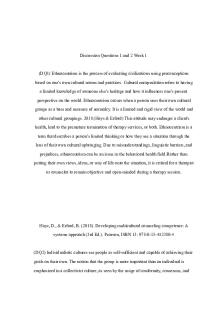Discussion Questions Radiolab PDF

| Title | Discussion Questions Radiolab |
|---|---|
| Course | Physiological Psychology |
| Institution | Saint Louis University |
| Pages | 1 |
| File Size | 85.6 KB |
| File Type | |
| Total Downloads | 42 |
| Total Views | 133 |
Summary
reading discussions ...
Description
Name: ____________________________ Discussion Questions for Radiolab Colors. How did Isaac Newton try to study whether colors were in the world or in the head? Newton took a bodkin and poked his eye and dark colored circles appeared (this didn’t get him very far) So he got himself a prism and poked a hole in one of the blinds in the window and waiting until the sun hit the right spot on the prism, a colored image of the sun appeared (a rainbow). But how do you know the prism isn’t just making these lights? Held in the prism? Newton took a second prism and while the first was making the rainbow he moved a few feet away and held the second prism in the blue light and saw if the prism would ass more color to the blue light? Nothing happened. So then he inferred that the first prism is dividing light into constituent parts. Light is a physical thing in the physical world. You can test it. Is color an objective reality (in other words, is it a characteristic of the ‘real world’ or is it coded by brains)? How do we know? Light is a physical thing! Colors are energy of light led to green light effect Scientists can say: The colors we see are tricks of the imagination and there is no perfectly objective view of color What determines the number of colors that different animals can see? Which animals can see better than humans? Animals are colorblind. If a dog, human and sparrow were looking at a rainbow, they would see different things. Humans see 7 colors of the rainbow. Dogs see Blue first, then green, then disappearing with a tiny little yellow. Dogs don’t have red cones in the eyes. They only have two cones, whereas we have three cones. o Red can mix with yellow to get orange and etc. o So when adding one more cone, you add about 98 extra colors. Sparrows see ultraviolet, violet, blue, green, orange, see further into the red (more sensitive red receptors). See a broader rainbow. Butterflies (five cones) see more than we do as well; ultraviolet, violet, blue blue green, green green orange, red, and more. Mentis Shrimps: (16 cones)!! How can a gene x environment interaction explain individual differences in color vision? The genes for the cones are in the X-chromosomes, which means that women have two sets of these genes (but one is just a spare). Yet, very rare that a woman will have not three, but four cones that work. (Green, blue, yellow, red cone.) The yellow would mix with the other colors to create thousands of new colors. (A DNA/blood test can determine this in people). Why can some people with this cone see differences in yellow and some can’t? o It depends on your environment! If you never need to use that cone to see that color, you don’t completely open up that color and it may remain dormant. o Those other colors are just not around enough for this humans, so they don’t practice seeing these lights. Is the sky really blue? No, Blue light is scattered in all directions by the tiny molecules of air in Earth's atmosphere. Blue is scattered more than other colors because it travels as shorter, smaller waves. This is why we see a blue sky most of the time....
Similar Free PDFs

Discussion Questions Radiolab
- 1 Pages

Discussion Questions
- 4 Pages

Discussion Questions
- 3 Pages

Digestion Radiolab Extra Credit
- 2 Pages

Discussion Questions Other Wes
- 3 Pages

Discussion Questions 12
- 1 Pages

Accounting 102 discussion questions
- 25 Pages

Dbq - discussion based questions
- 8 Pages

Chapter 12 Discussion Questions
- 2 Pages

Discussion Questions Week1
- 2 Pages

Online Discussion Questions
- 6 Pages

Seminar-Discussion-Questions Answers
- 29 Pages

Unit 1 Discussion Questions
- 3 Pages

Chapter 7 Discussion Questions
- 2 Pages
Popular Institutions
- Tinajero National High School - Annex
- Politeknik Caltex Riau
- Yokohama City University
- SGT University
- University of Al-Qadisiyah
- Divine Word College of Vigan
- Techniek College Rotterdam
- Universidade de Santiago
- Universiti Teknologi MARA Cawangan Johor Kampus Pasir Gudang
- Poltekkes Kemenkes Yogyakarta
- Baguio City National High School
- Colegio san marcos
- preparatoria uno
- Centro de Bachillerato Tecnológico Industrial y de Servicios No. 107
- Dalian Maritime University
- Quang Trung Secondary School
- Colegio Tecnológico en Informática
- Corporación Regional de Educación Superior
- Grupo CEDVA
- Dar Al Uloom University
- Centro de Estudios Preuniversitarios de la Universidad Nacional de Ingeniería
- 上智大学
- Aakash International School, Nuna Majara
- San Felipe Neri Catholic School
- Kang Chiao International School - New Taipei City
- Misamis Occidental National High School
- Institución Educativa Escuela Normal Juan Ladrilleros
- Kolehiyo ng Pantukan
- Batanes State College
- Instituto Continental
- Sekolah Menengah Kejuruan Kesehatan Kaltara (Tarakan)
- Colegio de La Inmaculada Concepcion - Cebu

